The 2017 KTM motocross family includes a new KTM 250 SX and new WP AER 48 forks and traction control for the four-strokes.
KTM has taken the wraps off of its 2017 line of production motocross machines yesterday, with many of the big boys receiving significant upgrades over the 2016 models, although none more intensive than the 2017 KTM 250 SX two-stroke.
2017 KTM 250 SX
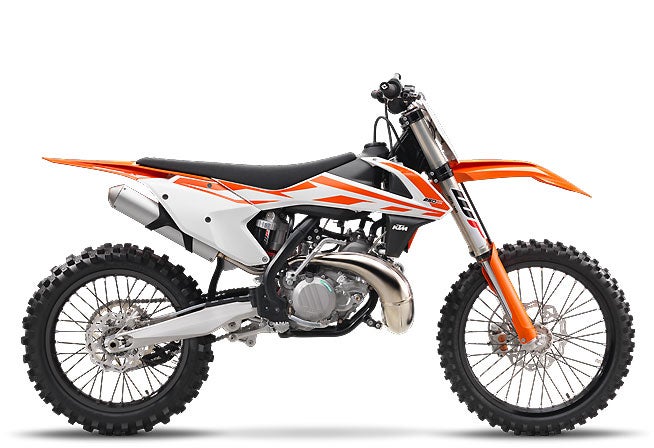
The 250 SX’s 249c, liquid-cooled, two-stroke engine is all new, designed for more power and better mass centralization. It retains the same 66.4mm x 72mm bore and stroke as before, but it features a new cylinder with KTM’s Twin Valve Control (TVC) power valve, new engine cases, a new counter balance shaft to reduce engine vibration, a revised five-speed transmission and a hydraulically operated DDS clutch. The cylinder boasts all-new ports and is fitted with an overhauled TVC power valve system that allows for easy changes to the bike’s power curve by swapping power valve springs. The cylinder also features new water jackets in the cylinder and head for better heat dissipation.
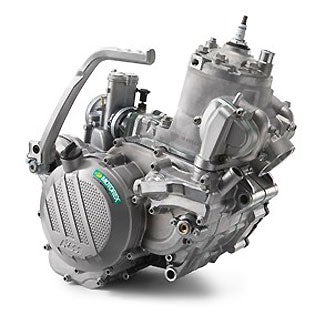
All-new die-cast engine cases place the clutch 8mm higher the crankshaft 27mm higher crankshaft. In addition to improving mass centralization the juggling of the shaft positions also allows the implementation of a counterbalance shaft to make the 250 SX even smoother. Redesigned engine covers feature a smart surface structure in order to reduce the wear caused by the rider’s bots.
For 2017, all KTM two-stroke models are fitted with new Mikuni TMX carburetors, replacing the Keihin’s used previously. The 38mm TMX proved to provide smoother and more controllable power all the way up to the rev limiter during testing. It’s also less sensitive to different altitudes and temperatures.
The 250 SX also gets a new chrome-moly chassis that is 2.2 lbs. lighter than the previous frame. The chassis boasts high torsional rigidity and low longitudinal stiffness for better bump absorption, which can help reduce rider fatigue. Laterally attached, lightweight engine head also help to reduce engine vibration felt by the rider. KTM says the chassis is also easier to maintain, easier to work on and supplies more space for the tank and other components.
The 250 SX also receives the latest version of the WP AER 48mm air fork. Delivering 12.4 inches of travel, the AER is a 48mm USD air-sprung fork developed by WP in close collaboration with KTM. It’s a split design with separate functions in each leg. The damping functions are in the right leg, and the air spring is in the left leg, the latter featuring a two chambers with a capsuled air cartridge to prevent loss of air pressure. Should the outer seal start to leak, the internal cartridge pressure will prevent the suspension from sacking. The air spring is adjusted via a single air valve, and the proper air pump is supplied with the bike.
The right fork leg’s damping cartridge can be adjusted to the track conditions and the rider’s preferences with a twist of a dial (compression from the top, rebound from the bottom, 30 clicks each). WP also redesigned the AER 48’s outer tubes to effect different bending characteristics that are claimed to result in smoother action.
KTM also updated the settings of the 250 SX’s piggyback reservoir shock and equipped it with a softer spring. This was done to balance the action of the rear suspension system with the new WER 48 fork. Rear suspension travel is 11.8 inches.
A new triple clamp has also been spec’d for 2017. The upper clamp has been redesigned to accommodate the new fork tubes, and its handlebar rubber-mounting system has been reworked to be more effective at isolating vibration to the rider. The lower handlebar clamps are now separated, while on the upper side a new bridge-type clamp is designed to add more torsional stiffness. It can also be replaced easily if it should be twisted due to a crash.
Other changes for 2017 include a 10mm longer rear brake pedal to give the rider better leverage for easier rear brake modulation and new aluminum head stays that slightly alter the rigidity of the chassis.
2017 KTM 450 SX-F
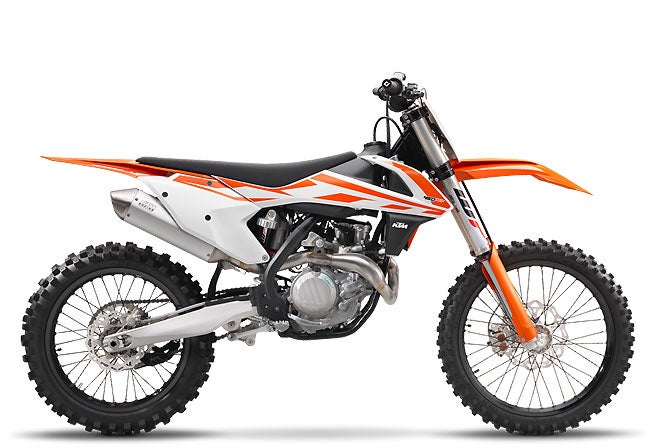
KTM’s flagship 450 SX-F returns with two more AMA national championship titles under its belt and noteworthy updates, the most significant being the most significant being the WP AER 48mm air fork. Delivering 12.4 inches of travel, the AER is a 48mm USD air-sprung fork developed by WP in close collaboration with KTM. It’s a split design with separate functions in each leg. The damping functions are in the right leg, and the air spring is in the left leg, the latter featuring a two chambers with a capsuled air cartridge to prevent loss of air pressure. Should the outer seal start to leak, the internal cartridge pressure will prevent the suspension from sacking. The air spring is adjusted via a single air valve, and the proper air pump is supplied with the bike.
The right fork leg’s damping cartridge can be adjusted to the track conditions and the rider’s preferences with a twist of a dial (compression from the top, rebound from the bottom, 30 clicks each). WP also redesigned the AER 48’s outer tubes to effect different bending characteristics that are claimed to result in smoother action.
Out back, KTM revised the suspension settings of the 450 SX-F’s piggyback reservoir shock and equipped it with a softer spring. This was done to balance the action of the 450SX-F’s rising-rate linkage rear suspension system with the new WER 48 fork. Rear suspension travel is 11.8 inches.
The 450 SX-F also features a new traction control system in the SX-F’s Keihin Engine Management system. The traction control feature works by analyzing throttle input from the rider and the rate at which rpm increases in the engine. If the rpm increases too quickly, the EMS will register a loss of grip and reduce the amount of power to the rear wheel ensuring maximum traction. The system is activated via a new handlebar-mounted map switch that allows for easy switching between two different engine maps and also activates the launch control, which helps to reduce wheel spin and improve traction off the starting line.
A new triple clamp has also been spec’d for 2017. The upper clamp has been redesigned to accommodate the new fork tubes, and its handlebar rubber-mounting system has been reworked to be more effective at isolating vibration to the rider. The lower handlebar clamps are now separated, while on the upper side a new bridge-type clamp is designed to add more torsional stiffness. It can also be replaced easily if it should be twisted due to a crash.
Other changes for 2017 include a 10mm longer rear brake pedal to give the rider better leverage for easier rear brake modulation and new aluminum head stays that slightly alter the rigidity of the chassis.
2017 KTM 250 SX-F/350 SX-F
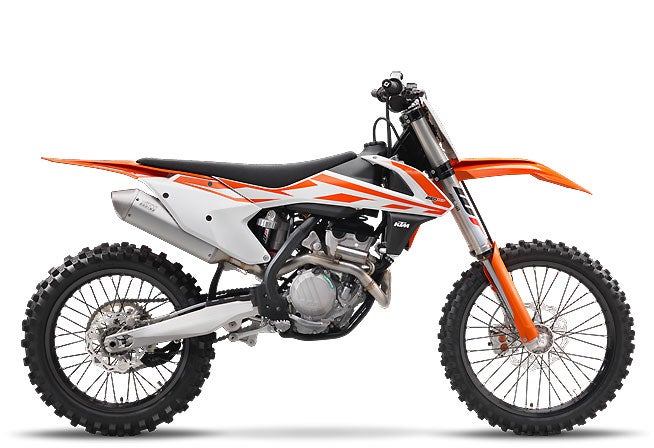
The 2017 KTM 250 SX-F and 350 SX-F still feature the high-winding DOHC, fuel-injected, four-stroke, single-cylinder architecture as before, but the smaller four-strokes also receive the same updates made to the 2017 KTM 450 SX-F.
These include the WP AER 48mm air air-sprung fork, which houses separate functions in each leg. The left leg features two chambers with a capsuled air cartridge to prevent loss of air pressure. Should the outer seal start to leak, the internal cartridge pressure will prevent the suspension from sacking. The air spring is adjusted via a single air valve, and the proper air pump is supplied with the bike. The right fork leg’s damping cartridge can be adjusted to the track conditions and the rider’s preferences with a twist of a dial (compression from the top, rebound from the bottom, 30 clicks each). WP also redesigned the AER 48’s outer tubes to effect different bending characteristics that are claimed to result in smoother action.
Out back, KTM revised the suspension settings of the 250 SX-F and 350SX-F’s piggyback reservoir shock and opted for a softer spring to balance the action of the front and rear suspension. Suspension travel is 12.4 inches up front and 11.8 inches out back.
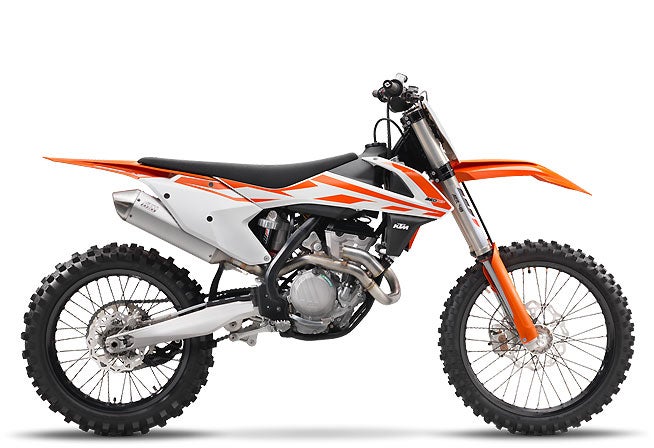
The 250 SX-F and 350 SX-F also get the latest Keihin EMS with the new traction control feature, which works by analyzing throttle input from the rider and the rate at which rpm increases in the engine. If the rpm increases too quickly, the EMS will register a loss of grip and reduce the amount of power to the rear wheel ensuring maximum traction. The system is activated via a new handlebar-mounted map switch that allows for easy switching between two different engine maps and also activates the launch control, which helps to reduce wheel spin and improve traction off the starting line.
A new triple clamp has also been spec’d for 2017. The upper clamp has been redesigned to accommodate the new fork tubes, and its handlebar rubber-mounting system has been reworked to be more effective at isolating vibration to the rider. The lower handlebar clamps are now separated, while on the upper side a new bridge-type clamp is designed to add more torsional stiffness. It can also be replaced easily if it should be twisted due to a crash.
Other changes for 2017 include a 10mm longer rear brake pedal to give the rider better leverage for easier rear brake modulation and new aluminum head stays that slightly alter the rigidity of the chassis.
 Your Privacy Choices
Your Privacy Choices